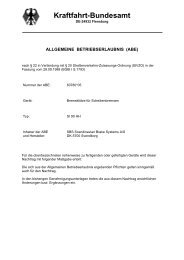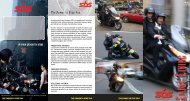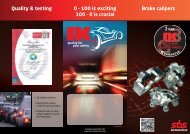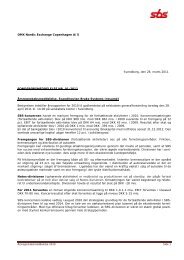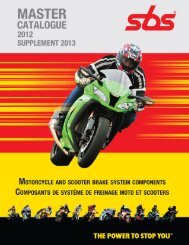notes - SBS
notes - SBS
notes - SBS
You also want an ePaper? Increase the reach of your titles
YUMPU automatically turns print PDFs into web optimized ePapers that Google loves.
16<br />
GB<br />
AIR BLEEDING – fig. no. 7-10<br />
7) Slowly pump the brake lever or pedal several times until no air<br />
bubbles can be seen rising up through the fluid from the hose<br />
at the bottom of the brake fluid reservoir.<br />
9) Apply handle (A) in order to empty the hose of the remaining<br />
fluid. Remove rubber pipe (B). Fit the brake fluid reservoir<br />
cover and rubber cap.<br />
PRODUCT INSTRUCTION<br />
8) A – Hold the brake applied (brake lever or pedal).<br />
B – Quickly open/close the bleeder nipple.<br />
C – Release the brake lever or pedal.<br />
A + B + C are to be repeated until no air bubbles can be<br />
seen in the brake system bleeder hose. Refill the brake fluid<br />
reservoir until upper level line.<br />
“CAUTION”<br />
10) ALWAYS empty bleeder of used brake fluid when half full.<br />
Please also see brake fluid warning instructions.<br />
“CAUTION”<br />
Do not attempt to drive the vehicle until a firm brake lever or pedal is obtained<br />
by pumping the brake lever or pedal until the pads/shoes touch the disc/drum.<br />
The brake may not function on the first application of the lever or pedal if this<br />
is not done.<br />
For some vehicle brake applications a different brake fluid bleeding system<br />
may apply. In such case instruction of the vehicle manufacturer must be<br />
followed.<br />
MADE IN DENMARK






